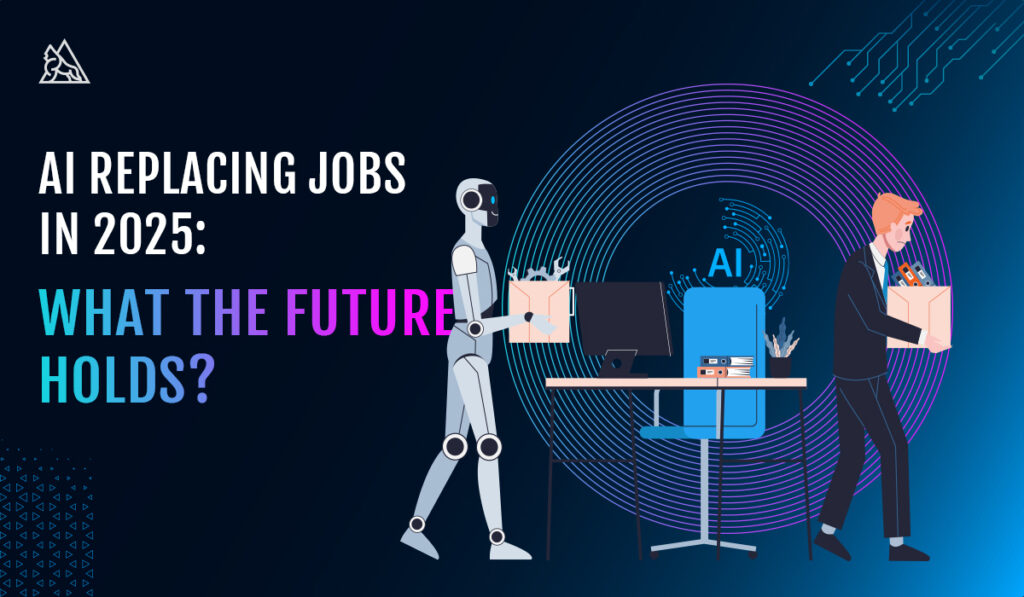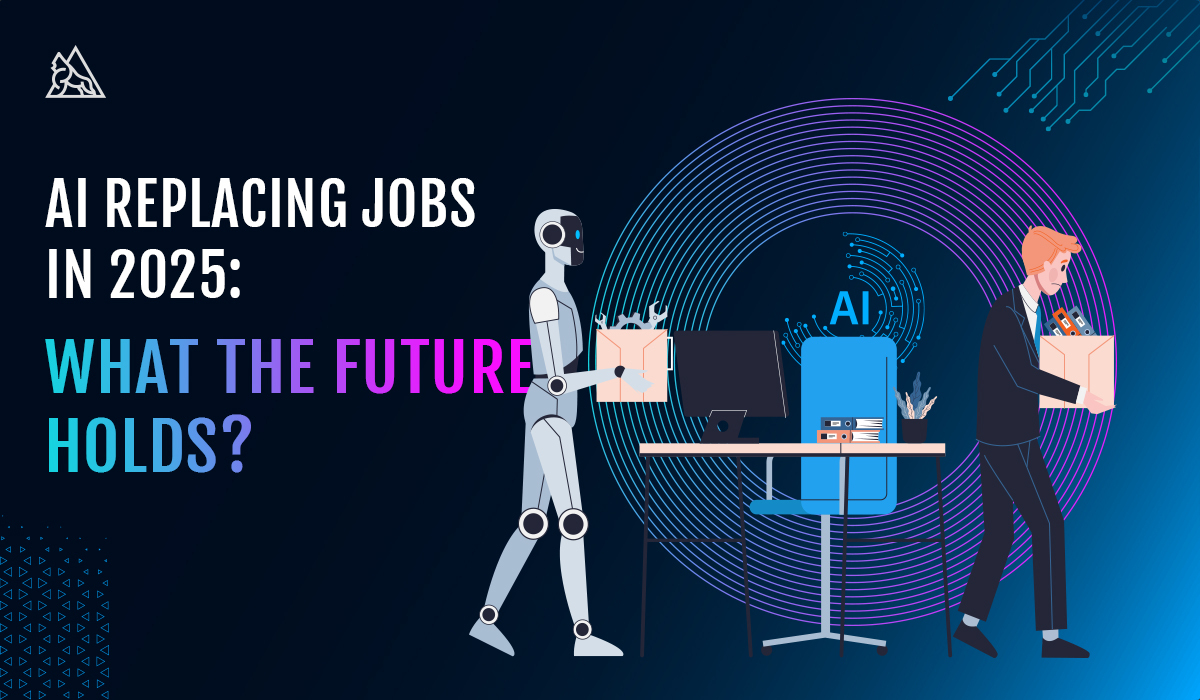The rise of artificial intelligence (AI) is no longer a futuristic idea—it’s happening now, and it’s changing the way we work. By 2025, AI is expected to replace or transform a significant number of jobs across various sectors. While AI brings innovation and increased efficiency, it also raises concerns about mass job displacement, economic inequality, and societal impacts.
In this blog, we will explore how AI is likely to replace jobs by 2025, which roles are most at risk, and what we can do to prepare for the future.
Understanding AI and Its Capabilities in 2025
AI refers to machines and software that can perform tasks that typically require human intelligence. These tasks include things like problem-solving, learning, pattern recognition, and decision-making. In 2025, AI is expected to be even more advanced, with capabilities that will allow machines to perform complex, data-driven tasks traditionally done by humans.
We’re already seeing AI’s impact in areas such as automation, data analysis, and virtual assistants. AI systems can process vast amounts of data, learn from patterns, and make decisions faster than humans. These advancements are setting the stage for significant changes in the job market.
AI will be particularly effective in industries where repetitive tasks, data analysis, and routine decision-making are prominent. Let’s take a closer look at which jobs are most vulnerable to AI replacement by 2025.
Jobs Most Vulnerable to AI Replacement in 2025
Manufacturing and Factory Jobs
Manufacturing has long been an industry dominated by human labor, but this is rapidly changing. By 2025, AI-powered robots and automated systems will have replaced many of the manual labor tasks that once required workers in factories and warehouses. These systems can assemble products, perform quality control, and even manage supply chains.
Automated robots are already being used in industries like automotive manufacturing, and their capabilities are expanding into sectors like electronics and food processing. These robots work faster and more precisely than humans, and they don’t need breaks. This makes them highly attractive to companies looking to increase efficiency and reduce costs.
Customer Service and Retail
Customer service is another area where AI is taking over. AI-powered chatbots and virtual assistants are becoming common in industries such as banking, retail, and telecommunications.
These AI systems can handle customer inquiries, resolve issues, and even provide personalized recommendations—tasks that would have previously been performed by human agents.
In retail, self-checkout machines and automated stock management systems are already replacing cashiers and stock clerks. By 2025, more customer-facing roles, such as store attendants and call center agents, may be automated, reducing the need for human workers in these positions.
Transportation and Delivery Services
Self-driving vehicles are no longer science fiction. Autonomous cars, trucks, and drones are being developed and tested, with plans to roll out more extensively in the coming years. By 2025, these technologies could significantly disrupt transportation and delivery jobs.
Truck drivers, delivery drivers, and even taxi drivers could see their jobs replaced by AI-powered autonomous vehicles. With AI driving vehicles, companies will be able to reduce labor costs, and logistics will become more efficient. However, this shift will also result in job displacement for millions of workers who rely on transportation-based jobs.
Administrative and Clerical Jobs
Administrative and clerical roles have long been a vital part of many industries, but they are increasingly becoming susceptible to automation. AI tools can handle repetitive tasks like scheduling, data entry, filing, and document processing. With these technologies in place, roles like secretaries, receptionists, and data processors will be at risk.
AI is also able to streamline administrative workflows by using natural language processing to respond to emails or generate reports. This level of automation frees up time for more complex and strategic tasks, but it also reduces the need for human involvement in basic administrative functions.
Healthcare and Diagnostic Roles
While AI is often seen as a tool to assist healthcare professionals, it is also capable of replacing some jobs in the medical field. AI systems are already being used to analyze medical images, detect patterns in patient data, and even make diagnoses in certain conditions. By 2025, AI may play an even bigger role in diagnostics, reducing the need for radiologists and other diagnostic experts.
In addition, administrative roles in healthcare settings, such as appointment scheduling, billing, and medical record keeping, could be automated using AI-driven systems. These advancements could increase the efficiency of healthcare delivery but may also lead to job losses in administrative and support roles.
The Benefits of AI Replacing Jobs
While the idea of AI replacing jobs can be unsettling, there are clear benefits that come with the integration of AI into the workforce.
- Increased Efficiency and Productivity: AI can perform tasks faster and more accurately than humans, leading to significant productivity gains across industries. This can result in higher outputs with fewer errors and less wasted time.
- Lower Operational Costs: With AI handling routine and repetitive tasks, businesses can cut labor costs and allocate resources to more strategic functions. This can lead to lower prices for consumers and improved profit margins for companies.
- Enhanced Safety: In dangerous sectors such as mining, manufacturing, and hazardous material handling, AI can perform risky tasks that would otherwise put human workers at risk. This reduces workplace injuries and fatalities.
- Creation of New Roles: While AI may replace certain jobs, it will also create new ones. Roles such as AI ethicists, robot maintenance technicians, and AI trainers will emerge as a result of the increased use of these technologies.
The Challenges of AI Replacing Jobs
Despite the benefits, AI replacing jobs comes with significant challenges.
- Job Displacement: One of the biggest concerns is the potential for widespread job losses, especially for workers in low-skill and repetitive job sectors. Many workers may not have the skills necessary to transition into new roles, leading to unemployment and financial instability for some.
- Economic Inequality: As AI disrupts industries, there is a risk of increasing economic inequality. Those who possess the skills to work with AI technologies will likely thrive, while those who cannot adapt may be left behind. This divide could deepen the gap between the wealthy and the working class.
- Psychological and Societal Effects: The widespread displacement of workers could lead to feelings of alienation, anxiety, and societal unrest. As people lose their sense of purpose and identity tied to their jobs, mental health issues may become more prevalent.
- Ethical Concerns: AI decision-making can sometimes be biased or lack empathy. In industries like healthcare or law enforcement, where human judgment and compassion are essential, AI may not be able to fully replicate the nuances of human interaction.
Preparing for the Future: How Workers and Industries Can Adapt
To ensure that AI’s rise is as beneficial as possible, workers and industries must take proactive steps to adapt.
- Upskilling and Reskilling: Workers in vulnerable sectors should focus on acquiring new skills that are in high demand, such as data analysis, AI programming, or cybersecurity. By embracing lifelong learning, workers can remain competitive in a rapidly changing job market.
- New Job Opportunities: While some jobs will disappear, others will emerge. Fields such as AI ethics, robotics maintenance, and data science will see increased demand. Workers who adapt to these fields will be well-positioned to thrive in the new AI-powered economy.
- Government and Corporate Support: Governments and companies must collaborate to provide retraining programs and safety nets for displaced workers. Offering financial support and access to education can help smooth the transition for individuals facing job loss.
Conclusion
AI replacing jobs by 2025 is inevitable, but it’s not all bad news. While some roles will be displaced, this shift also brings new opportunities for growth and innovation. The key is how we adapt. Workers need to focus on reskilling and lifelong learning, while businesses and governments must provide the support necessary for a smooth transition.
The real question is not whether AI will replace jobs, but how we embrace the change. By working together, we can ensure a future where both humans and AI thrive. So, as we look ahead, let’s see this as an opportunity to shape a world where technology empowers us to achieve more, not replace us. The future is in our hands—let’s make it a future worth looking forward to.










